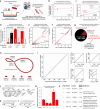Multidimensional third-generation sequencing of modified DNA bases allows interrogation of complex biological systems
- PMID: 40593667
- PMCID: PMC12215381
- DOI: 10.1038/s41467-025-60896-x
Multidimensional third-generation sequencing of modified DNA bases allows interrogation of complex biological systems
Abstract
DNA exists biologically as a highly dynamic macromolecular complex subject to myriad chemical modifications that alter its physiological interpretation, yet most sequencing technologies only measure Watson-Crick base pairing interactions. Third-generation sequencing technologies can directly detect novel and modified bases, yet the difficulty and cost of training these techniques for each novel base has so far limited this potential. Here, we present a method based on barcoded split-pool synthesis to generate reference standard oligonucleotides allowing novel base sequencing. Using novel base detection, we perform multidimensional sequencing to retrieve information, both physiologically stored and experimentally encoded, from DNA, allowing us to characterize the preferential replication of deleterious mitochondrial genome mutations, the infection dynamics of a host-pathogen model, and the effect of chemotherapy on cancer cell DNA at the single molecule level. The low cost and experimental simplicity of this method make this approach widely accessible to the research community, enabling complex experimental interrogation across the biological sciences.
© 2025. The Author(s).
Conflict of interest statement
Competing interests: The authors declare no competing interests.
Figures






References
-
- Allis, C. D. & Jenuwein, T. The molecular hallmarks of epigenetic control. Nat. Rev. Genet.17, 487–500 (2016). - PubMed
MeSH terms
Substances
Grants and funding
LinkOut - more resources
Full Text Sources

